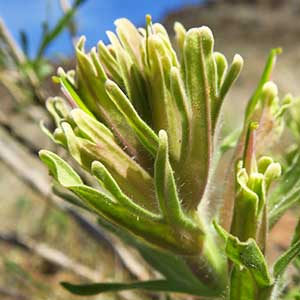Castilleja xanthotricha
Castilleja salsuginosa
John Day or yellow-hairy paintbrush, John Day paintbrush, yellow hair paintbrush, yellow-hair Indian paintbrush
Monte Neva Indian paintbrush, Monte Neva paintbrush
few to several, ± decumbent to erect or ascending, unbranched, sometimes with short, leafy axillary shoots, hairs erect to spreading, long, soft, eglandular, mixed with short stipitate-glandular ones.
several, erect, usually decumbent at base, unbranched, sometimes branched, sometimes with short, leafy axillary shoots, hairs spreading, short, rather stiff, some glandular.
green, linear, lanceolate to broadly lanceolate, oblong, or cuneate, 0.8–5 cm, not fleshy, margins plane to wavy, involute, 0–5-lobed, apex acute, sometimes rounded;
lobes spreading, linear, arising below mid length, nearly as broad as center lobe, apex acute.
purplish brown with a grayish cast (due to adhering soil particles and salt crystals), linear to narrowly lanceolate, 1.5–2.5(–3) cm, fleshy, margins plane, sometimes wavy, involute, 0–3(–5)-lobed, apex acute;
lobes spreading, linear to narrowly lanceolate, apex obtuse.
3–14 × 1.5–4.5 cm;
bracts proximally greenish, rarely dull reddish purple, distally white to cream, rarely pale yellow or dull, pale pink (sharply differentiated from proximal coloration), lanceolate or oblong to narrowly ovate, (3–)5–7-lobed;
lobes ascending, linear to obovate, ± broadened distally, medium, long, proximal lobes arising below mid length, central lobe apex broadly rounded to truncate, others acute to rounded.
3–10 × 1.5–5 cm;
bracts proximally purplish, deep burgundy, lavender, dull reddish, or deep purple, distally greenish, white, cream, or pink on margins and apices, oblong, 3(–5)-lobed;
lobes ascending, ± linear, medium length, arising above mid length, central lobe apex rounded to obtuse, expanded distally, lateral ones acute.
curved, 17–23 mm;
tube 15–19 mm;
beak exserted, adaxially green, 5–8(–9) mm, puberulent, stipitate-glandular;
abaxial lip deep purple (color sometimes visible through calyx), green, pinkish, or pale yellow, ± prominent, slightly inflated, usually hidden in calyx, sometimes right at top of calyx, 2 mm, ca. 50% as long as beak;
teeth ascending, whitish, yellowish, pink, or green, 1–1.5 mm.
straight or slightly curved, 18–22(–24) mm;
tube 13–18 mm;
beak, sometimes abaxial lip, exserted;
beak adaxially purplish brown, 4.5–6.5 mm, conspicuously exceeding abaxial lip, margins reddish or colored as bracts, apices white or cream;
abaxial lip reddish purple with green in a distal band or along grooves, gradually inflated, grooved, (2–)3–4(–4.5) mm, 67% as long as beak;
teeth erect to slightly spreading, white to cream, often with purple spot, 1.4–2(–2.5) mm.
colored as bracts, 15–26 mm;
abaxial and adaxial clefts 3.5–7 mm, 25–50% of calyx length, deeper than laterals, lateral 2–5 mm, 12–25% of calyx length;
lobes linear, oblong, or narrowly triangular, center lobe apex usually rounded, lobes acute to rounded.
proximally whitish, distally purple to sometimes pink, margins white or cream, 16–20 mm;
abaxial and adaxial clefts 5–8.5 mm, 20–45% of calyx length, all 4 clefts subequal;
lobes linear or narrowly lanceolate, apex obtuse to rounded.
blackish.
= 48.
= 24.
Castilleja xanthotricha
Castilleja salsuginosa
Castilleja xanthotricha is endemic to moderate elevations in the sagebrush hills of the John Day River drainage in north-central Oregon. N. H. Holmgren (1971) hypothesized that this tetraploid species is of allopolyploid hybrid origin between C. glandulifera and C. oresbia.
(Discussion copyrighted by Flora of North America; reprinted with permission.)
Castilleja salsuginosa is endemic to a single site in White Pine County, where it is limited to the harsh alkaline soils of travertine hot springs. This population is threatened by habitat degradation from livestock, as well as by water developments affecting the hydrology of the hot spring system. Castilleja salsuginosa is closely related to C. nana and C. pilosa, but genetic studies of the trio are inconclusive so far. Two populations of very similar but slightly smaller-flowered plants occur around other hot springs in adjacent Eureka County. While they resemble C. salsuginosa superficially, recent morphometric studies of one of these populations indicate that they may be worthy of nomenclatural recognition, separate from C. salsuginosa.
Castilleja salsuginosa is in the Center for Plant Conservation’s National Collection of Endangered Plants.
(Discussion copyrighted by Flora of North America; reprinted with permission.)
